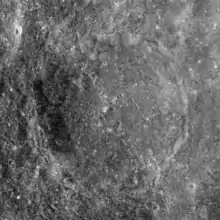 Apollo 17 Mapping camera image | |
| Coordinates | 3°06′S 114°30′E / 3.1°S 114.5°E |
|---|---|
| Diameter | 61 km |
| Colongitude | 246° at sunrise |
| Eponym | Andreas Vesalius |
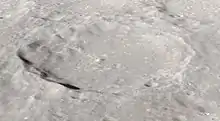
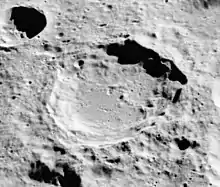
Vesalius is a lunar impact crater that lies on the far side of the Moon, less than 100 kilometers south of the lunar equator. It was named after Flemish anatomist and physician Andreas Vesalius.[1] Just to the northwest is the slightly smaller crater Buisson. Farther to the west-southwest lies the prominent crater Einthoven.
The outer rim of Vesalius is generally circular but somewhat irregular. There is an outward bulge at the southern extremity and a low rim at the northern end. The inner wall displays some slight terracing. On the interior floor the central peak is offset to the north, suggesting that the crater was formed by a low-angle impact.
Satellite craters
By convention these features are identified on lunar maps by placing the letter on the side of the crater midpoint that is closest to Vesalius. The name Eskola was proposed for Vesalius M crater, and it is shown as such in some publications,[2] but the name was not approved by the IAU.
| Vesalius | Latitude | Longitude | Diameter |
|---|---|---|---|
| C | 0.8° S | 116.7° E | 22 km |
| D | 2.2° S | 116.9° E | 50 km |
| G | 3.7° S | 117.3° E | 14 km |
| H | 3.9° S | 119.0° E | 36 km |
| J | 4.8° S | 119.1° E | 25 km |
| M | 5.7° S | 114.5° E | 31 k |
 Oblique Lunar Orbiter 1 view of Vesalius M
Oblique Lunar Orbiter 1 view of Vesalius M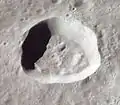 Apollo 12 image of Vesalius M
Apollo 12 image of Vesalius M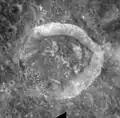 Apollo 17 Mapping camera image of Vesalius M
Apollo 17 Mapping camera image of Vesalius M
References
- ↑ "Vesalius (crater)". Gazetteer of Planetary Nomenclature. USGS Astrogeology Research Program.
- ↑ Apollo 17 Preliminary Science Report (NASA Special Publication 330). Scientific and Technical Information Office, National Aeronautics and Space Administration, Washington, D.C. 1973. Figure 28-8.
- Andersson, L. E.; Whitaker, E. A. (1982). NASA Catalogue of Lunar Nomenclature. NASA RP-1097.
- Bussey, B.; Spudis, P. (2004). The Clementine Atlas of the Moon. New York: Cambridge University Press. ISBN 978-0-521-81528-4.
- Cocks, Elijah E.; Cocks, Josiah C. (1995). Who's Who on the Moon: A Biographical Dictionary of Lunar Nomenclature. Tudor Publishers. ISBN 978-0-936389-27-1.
- McDowell, Jonathan (July 15, 2007). "Lunar Nomenclature". Jonathan's Space Report. Retrieved 2007-10-24.
- Menzel, D. H.; Minnaert, M.; Levin, B.; Dollfus, A.; Bell, B. (1971). "Report on Lunar Nomenclature by the Working Group of Commission 17 of the IAU". Space Science Reviews. 12 (2): 136–186. Bibcode:1971SSRv...12..136M. doi:10.1007/BF00171763. S2CID 122125855.
- Moore, Patrick (2001). On the Moon. Sterling Publishing Co. ISBN 978-0-304-35469-6.
- Price, Fred W. (1988). The Moon Observer's Handbook. Cambridge University Press. ISBN 978-0-521-33500-3.
- Rükl, Antonín (1990). Atlas of the Moon. Kalmbach Books. ISBN 978-0-913135-17-4.
- Webb, Rev. T. W. (1962). Celestial Objects for Common Telescopes (6th revised ed.). Dover. ISBN 978-0-486-20917-3.
- Whitaker, Ewen A. (1999). Mapping and Naming the Moon. Cambridge University Press. ISBN 978-0-521-62248-6.
- Wlasuk, Peter T. (2000). Observing the Moon. Springer. ISBN 978-1-85233-193-1.